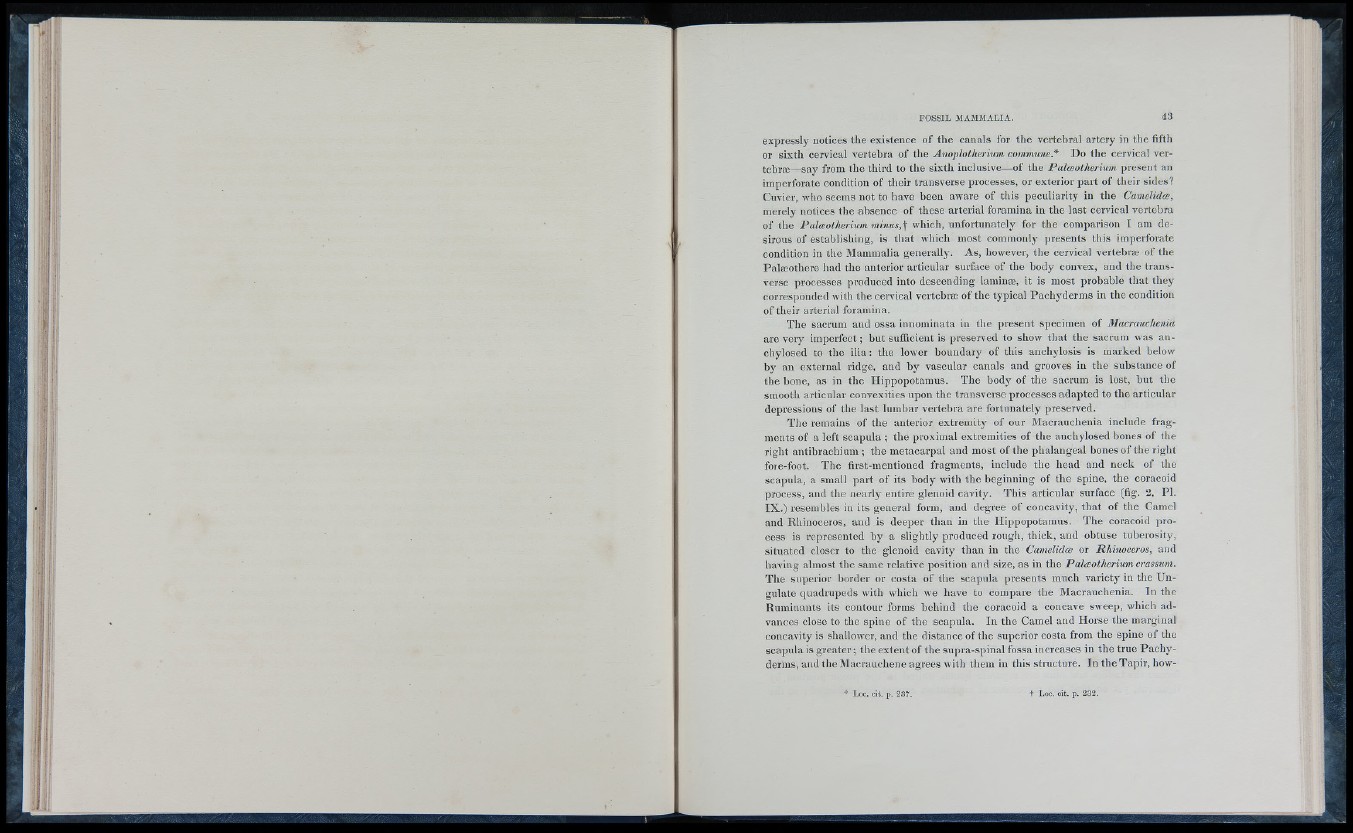
f :
expressly notices the existence o f the canals for the vertebral artery in the fifth
or six th cervical vertebra o f the Anoplotherium commune.* D o the cervical vertebræ—
say from the third to the six th inclusive—of the Paloeotherium present an
imperforate condition o f their transverse processes, or exterior part of their sides?
Cuvier, who seems not to have been aware o f this peculiarity in the Camelidæ,
merely notices the absence o f th ese arterial foramina in the last cervical vertebra
o f the Paloeotherium m in u s f which, unfortunately for the comparison I am desirous
o f establishing, is that which most commonly presents this imperforate
condition in the Mammalia generally. As, however, the cervical vertebræ o f the
Palæothere had the anterior articular surface o f the body convex, and the transverse
processes produced into descending laminæ, it is most probable that they
corresponded with the cervical vertebræ o f tlie typical Pachyderms in the condition
o f their arterial foramina.
Th e sacrum and ossa innominata in the present specimen o f Macrauchenia
are very imperfect ; but sufficient is preserved to show that the sacrum was anchylosed
to the ilia : the lower boundary o f this anchylosis is marked below
by an external ridge, and by vascular canals and grooves in the substance o f
the bone, as in the Hippopotamus. The body o f the sacrum is lost, but the
smooth articular convexities upon the transverse processes adapted to the articular
depressions o f the la st lumbar vertebra are fortunately preserved.
The remains o f the anterior extremity o f our Macrauchenia include fragments
o f a le ft scapula ; the proximal extremities o f the anchylosed bones o f the
right antibrachium ; the metacarpal and most o f the phalangeal bones o f the right
fore-foot. T h e tirst-mentioned fragments, include the head and neck o f the
scapula, a small part o f its body with the beginning o f the spine, the coracoid
process, and the nearly entire glenoid cavity. Th is articular surface (fig. 2, PI.
IX .) resembles in its general form, and degree o f concavity, that o f the Camel
and Rhinoceros, and is deeper than in the Hippopotamus. T he coracoid proc
e ss is represented by a slightly produced rough, thick, and obtuse tuberosity,
situated closer to the glenoid cavity than in the Camelidæ or Rhinoceros, and
having almost the same relative position and size, as in the Paloeotheriumcrassum.
The superior border or costa o f the scapula presents much variety in the U n gulate
quadrupeds with which we have to compare the Macrauchenia. In the
Ruminants its contour forms behind the coracoid a concave sweep, which advances
close to the spine o f the scapula. In the Camel and Horse the marginal
concavity is shallower, and the distance o f the superior costa from the spine o f the
scapula is greater ; the extent o f the supra-spinal fossa increases in the true P a c h y derms,
and the IMacrauchene agrees with them in this structure. In the Tapir, how-
Loc. cit. p. 237. + Loc. cit. p. 232.